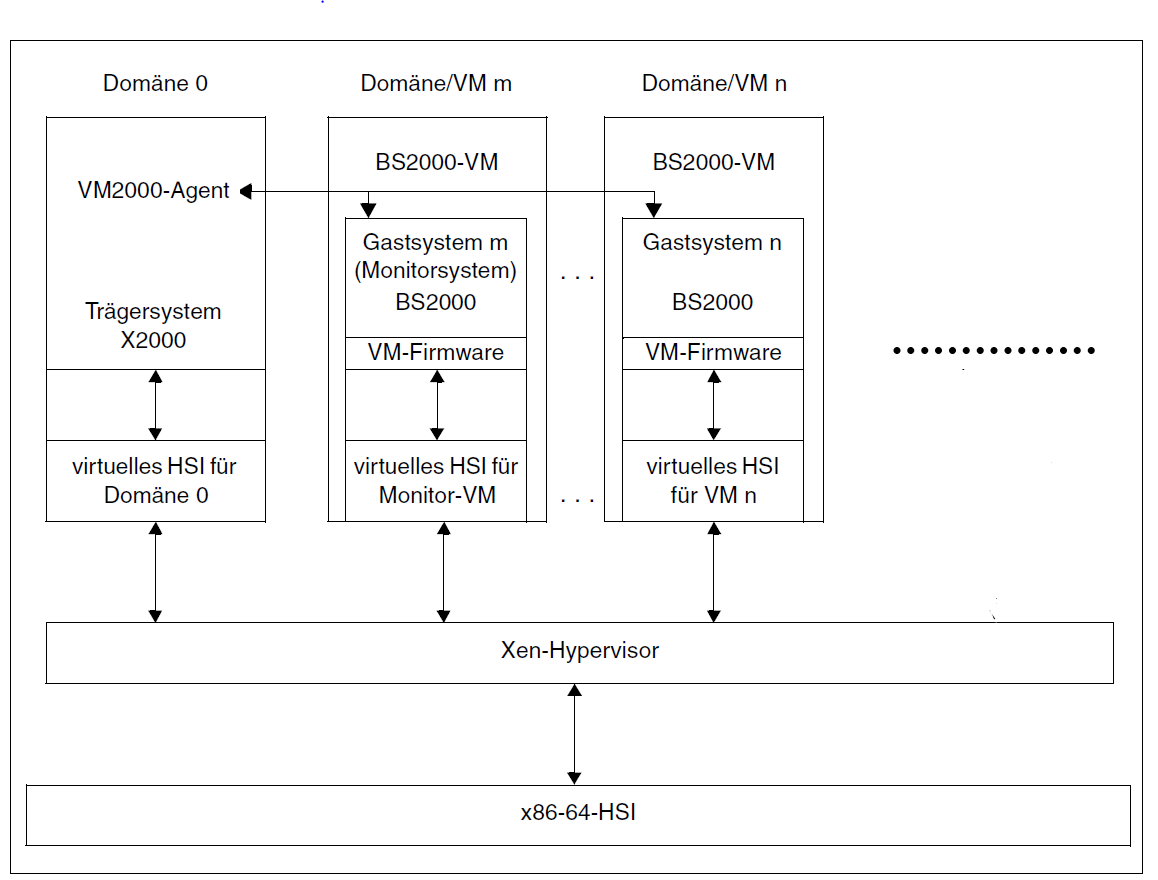Domains
On the Server Unit one or more operating systems can be started in virtual machines, the so called domains.
The first domain which is started automatically is of particular importance. This domain, which is called domain 0 (“Dom0”), is privileged and is used for management purposes. The carrier system X2000 executes in domain 0.
The Xen hypervisor and the I/O drivers in domain 0 operate and virtualize the Server Unit. The Xen hypervisor controls execution of all the domains (scheduling).
BS2000 systems can run in the nonprivileged domains (“DomU”).
Carrier system X2000
The X2000 carrier system executes under the Linux operating system in domain 0.
X2000 contains functions for supporting BS2000. It provides the operating functionality for devices (the BS2000 device emulation), and executes the physical inputs/outputs.
X2000 also implements the interface for operating the VMs via the SE manager or the Customer Support.
VM2000
BS2000 VMs can be configured and operated only when the software product VM2000 is installed and configured.
Before VM2000 mode is initialized, the operating mode "VM2000 mode" must be set with the SE Manager, see "Operating modes". In addition to domain 0, another special domain with the domain name MONITOR, the monitor VM, is then configured. The monitor system, which is a BS2000 guest system in which the VM2000 monitor and the other software components of VM2000 are embedded, executes on the monitor VM. The monitor system can then be started, see "Starting the monitor system".
The VM2000 functions and commands which are offered for BS2000 VMs are described in this manual. Fundamental VM2000 functions are also available to the SE server administrators via the SE Manager, see section "VM2000 functions in the SE Manager".
BS2000 guest systems can work together with VM2000, see section "VM2000 in the guest systems".
For hardware-related implementation of the functions, VM2000 utilizes the carrier system X2000. For communication purposes X2000 realizes another software component, the VM2000 Agent.
VM2000 Agent
The VM2000 Agent executes in domain 0. It is started only in VM2000 operation.
On the one hand the VM2000 Agent converts the requests of the VM2000 monitor and of the guest systems (the hypervisor calls) to corresponding administration or guest system requests. On the other hand the VM2000 Agent also registers events which are important for VM2000 operation and informs the VM2000 monitor and the BS2000 guest systems affected of these.
Firmware component of a VM
To execute, each BS2000 guest system requires a firmware component which converts the /390 code to the relevant x86-64 code of the Server Unit (CISC-FW) and offers the privileged HSI for the BS2000 guest system (HAL).
Each BS2000 VM of the Server Unit has its own such firmware component.
Operating levels
Actions for the BS2000 VMs can be initialized from various operating levels:
The full VM2000 functionality is available to the VM2000 and VM administrators via the user interface of VM2000 (see "VM2000 Operating strategy").
Fundamental VM2000 functions are also available to the SE server administrators via the SE Manager, see section "VM2000 functions in the SE Manager".
Information on global resources in VM2000 commands
The VM2000 commands also supply information relating to resources which the BS2000 VMs share with the carrier system (main memory, CPU performance):
/SHOW-VM-CPU-POOLsupplies information on all CPU pools of the Server Unit. This also includes information on the CPU pool of domain 0 (*POOL0).The output of
/SHOW-VM-RESOURCES INFORMATION=*MEMORY,ATTRIBUTE=*ALL/*ASSIGNEDalso supplies the amount of main memory occupied by the domain 0 (FOREIGN VMS)./SHOW-VM-RESOURCES INFORMATION=*CPU/*CONFIGURATIONsupplies information on all CPUs of the Server Unit, their status and the assignment to CPU pools. This also includes information on the CPU pools of domain 0 (*POOL0)./SHOW-VM-STATUS INFORMATION=*TIMERalso supplies information on the load on domain 0 in *POOL0.
Main memory
The Server Unit’s main memory contains a fixed portion for domain 0. The remaining main memory can be used for BS2000 VMs.
The planning for the assignment of the real main memory for VM2000 operation is the task of the Server Unit administration.
Information on the distribution of the main memory is provided by /SHOW-VM-RESOURCES INFORMATION=*MEMORY.
A BS2000 VM obtains the main memory in a granularity of 2 Mbyte or more. The main memory of a VM is not contiguous in the main memory of the Server Unit, but spread.
A small part of the main memory of a BS2000 VM is required for the firmware component of the VM. The VM’s firmware component continues to emulate a contiguous main memory starting with address 0 for a BS2000 guest system.
See also section "Managing main memory on SU x86".
CPUs, CPU pools
The real CPUs of the Server Unit are subdivided into static CPU pools during system initialization of the Server Unit. This subdivision is achieved by means of licenses. It can also be viewed using the VM2000 command /SHOW-VM-RESOURCES INFORMATION=*CPU/*CONFIGURATION.
In addition, further, unused real CPUs can exist (depending on the hardware and licenses) which are not assigned to a CPU pool. These unused CPUs automatically become cold spare CPUs.
The following static CPU pools are defined for VM2000 operation (the equivalent names in the VM2000 outputs and in the manual “Operation and Administration” [19] are specified in parentheses):
CPU Pool of domain 0 (
*POOL0, Pool-0).
It contains the CPUs for domain 0, i.e. for the X2000 carrier system.Standard CPU pool (
*STDPOOL, bs2_pool).
It contains the CPUs for VM2000 operation, possibly enhanced with extra CPUs.The initial number of CPUs in the standard CPU pool is the same as the number of BS2000 CPUs of the Server Unit, including the extra CPUs (license required). VM2000 manages and reconfigures only the CPUs of the standard CPU pool, see "Real CPUs".
With VM2000 further (dynamic) CPU pools can be created. See section "Managing CPU pools".
Devices
The real devices in the periphery are not directly visible for the monitor system and the other BS2000 guest systems. BS2000 guest systems know only the BS2000 devices emulated in X2000. See section "BS2000 devices connected to SU x86".

